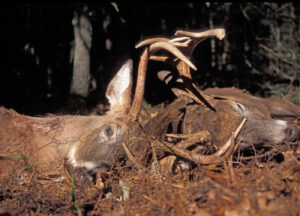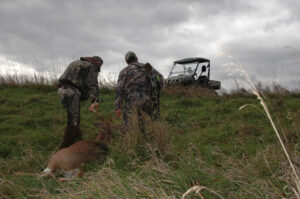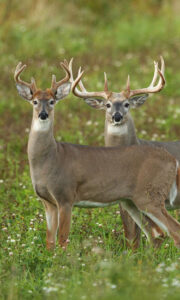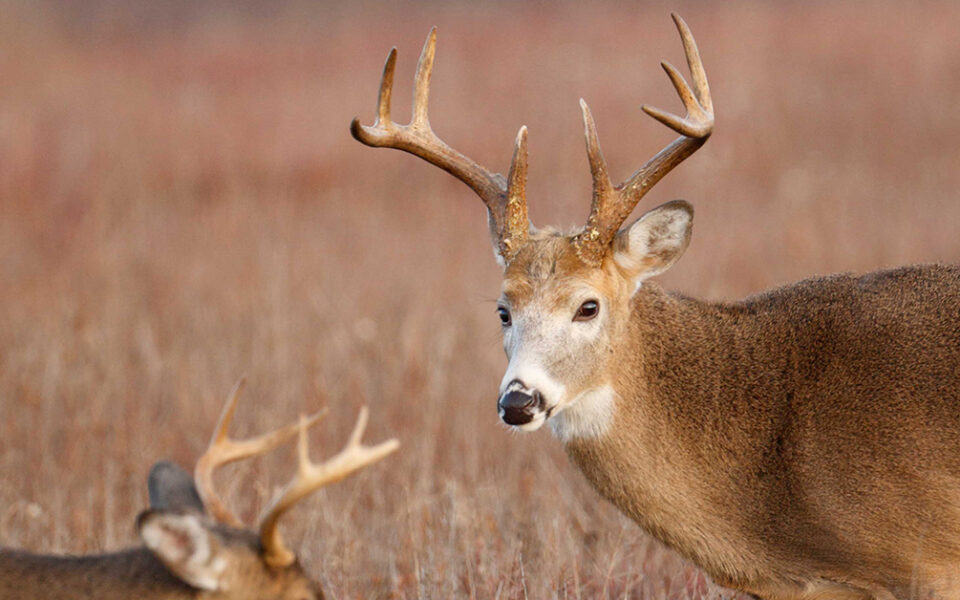First, let’s be clear what we’re talking about. Maturity is that point at which growth of an organism ceases. Annual plants grow, mature, go to seed and then die in a single season. Others, like aspen trees may grow for years, even decades before growth ceases. Still others, like oaks may continue to grow indefinitely. You may refer to a particularly large oak tree as mature, but by strict definition, it’s not. Despite what you may have heard, seen or read, mature whitetail bucks do not reach maturity until age four. At that time, its skeleton is fully formed. A deer may, and typically does, continue to put on weight, but its body has ceased growing. Folks sometimes lump three year old deer in this “mature category,” mostly so they can say they killed a “mature buck,” but like that ancient oak, they are not mature.
Common Reason Hunters See Fewer Mature Bucks

Now that we’re clear on the subject, let’s dispense with the most obvious and most common reason hunters see fewer mature bucks than they would like. For the answer, you need only look in the mirror. In order to reach maturity, a buck needs to be allowed to live until it is at least four. That isn’t happening in most places where public hunting is allowed, and even on a lot of private land where access is restricted.
My home state of Maine provides a good example. Historical records clearly show it has the potential, and once was a destination for those seeking bigger, older bucks. Today, yearlings make up just fewer than 50 percent of the annual buck harvest, which may not sound like a lot but it is one of the highest percentages in the nation. And that’s the statewide average. In more populated and heavily hunted regions of the state, where I live, the proportion of younger bucks killed is even higher. A legal buck is defined as one with at least three inches of antler and sadly, most of the people who hunt in my neck of the woods will not pass up any legal buck.
That makes it a lot tougher on the people I hunt with, who all hold out for older deer.
I generally run about a dozen trail cameras over roughly a two square mile area and during a typical year I may get photos of one, possibly two mature bucks. That’s it! Simply stated, “Dead deer can’t grow old!” But even under the best of circumstances, that’s not the only reason you’re not seeing more mature bucks.
Whitetail Population Demographics
Another reason is simple population demographics. In any population – except for the most intensively managed ones – you will always have decreasingly fewer individuals in older age classes. If you were to graph a typical deer population it might look like a pyramid or a triangle, with the oldest individuals at the top and the youngest at the base.
Regardless of whether hunting is permitted or not, every deer faces a certain risk of mortality. The longer they’re alive, the longer they’re exposed to the risk of disease, injury and predation. Add “hunting mortality,” which is nearly always directed primarily toward bucks, and the differences become more pronounced.
Furthermore, you can’t stockpile bucks. Even in well managed or intensively managed populations it’s difficult to maintain a high number of older deer. For starters, in order to achieve a high number of mature bucks your land and its habitat has to support a significantly higher number of younger bucks, which places added stress on the deer and their habitat, further increasing mortality. And like some people, as bucks get older they become increasingly less tolerant of others.
Social Interaction
The social structure of whitetail bucks has been finely-tuned over eons to ensure survival of the fittest. Summer is a laid-back period where males often associate in bachelor herds, and everyone gets along just peachy. As the days grow shorter bucks shed velvet, testosterone levels increase and the bucks start sorting out the dominance hierarchy. It begins with posing, posturing and gestures, even mutual grooming, then transitions into pushing and shoving matches. It’s designed, in part, to reduce more aggressive interactions and actual combat during the rut, which could put all individuals involved at higher risk. But the system isn’t perfect.
Close rivals continually test one another for signs of weakness and the more individuals present, the more interaction and confusion. Meanwhile, strangers from nearby properties who aren’t familiar with the local pecking order are wandering through the neighborhood every day stirring up trouble. And older bucks that may be passing their prime are also being challenged. The more older bucks you have, the more they fight. Some die in combat. Others die later from their wounds, or possibly succumb to disease or the elements as a result of their weakened state.
In short, a certain proportion of bucks will die every year whether you shoot them or not.
Pressure
Now let’s say you somehow miraculously addressed all the aforementioned issues. You, your guests and your neighbors are all passing up yearlings and two year olds, and even trying to let three year olds with the best potential walk. You’ve got your age and sex ratios optimally balanced (which never really happens but we’ll pretend, just for discussion sake) and your herd size is well balanced with available habitat and nutrition (which may not last), but you’re still not seeing mature bucks. Only this time, you know they’re there because you have pictures on your trail cameras.
 It’s time to “go back and look in the mirror again.” As you would expect, there is an inverse correlation between hunting pressure and daytime deer activity. The more time you or other hunters spend on the property, the less likely you are to see deer, especially older deer. Studies have shown that as hunting pressure increases, mature bucks move less during daylight. They also spend more time in thick cover, where you’re less likely to see them even if they do move.
It’s time to “go back and look in the mirror again.” As you would expect, there is an inverse correlation between hunting pressure and daytime deer activity. The more time you or other hunters spend on the property, the less likely you are to see deer, especially older deer. Studies have shown that as hunting pressure increases, mature bucks move less during daylight. They also spend more time in thick cover, where you’re less likely to see them even if they do move.
Another study found that mature bucks will actually learn to avoid permanent tree stands during daylight. Think about that for a minute while you consider about how you hunt. Do you hunt in a box blind over a green field? If so, you are significantly reducing your odds of seeing a mature buck no matter how many live on the property you hunt. There are other hunting methods that might produce more mature buck sightings, but it would take another feature article to discuss them. And we’d just be scratching the surface.
Whitetail Cover
What about habitat? You want to make your ground attractive so that more deer include it within their home range. Most of the attention is directed toward building food plots and planting mast orchards, and those are certainly great ways to attract deer. But you can have the best food in town and it’s still not enough. If you want to attract and hold deer, more deer than your neighbor does, you need to step back and consider a couple things.
Within their home range a deer has a “core area” where they spend most of their time. And how does a deer spend most of its day? I’ll give you a hint; it’s not feeding. The vast majority of a deer’s day (and night) is spent in bed. We should all be so lucky.
So, we know deer spend most of their day bedding. And we know that as hunting pressure increases deer seek out thicker cover, especially mature deer. What they seek even more than a full belly is a “security blanket.” Once you’ve got your food plots and orchards in shape, turn your attention to establishing and maintaining as much dense bedding cover as you can. This is especially important in agricultural areas or more open terrain where thick cover is lacking.
There are numerous ways to go about it. It can be as simple as leaving an area undisturbed, or rotating your fields so that some are set aside as CRP; or as complicated as removing overstory shade trees and/or hinge-gutting pole-stage trees to create bedding pockets. Even then you’re not doing as much as you could be.
Whitetail Sanctuaries
If you really want to attract and hold more mature deer on your property, you need to give them a place, or places, where they can be left completely alone, like “sanctuaries.” Like bedding areas, try to locate them in the central part of the property, away from neighbors and other forms of disturbance. And stay out! These should be considered forbidden zones, areas you never enter unless managing the property.

Paolomanzi
One obvious exception to the rule is when recovering a wounded deer. Even then, you should minimize disturbance to the greatest extent possible. Conventional wisdom says you should only enter at night to recover a deer. I understand the logic, but disagree with that on the tough tracking jobs because your odds of recovering a wounded deer increase exponentially if you search for it in daylight.
Yearling Buck Dispersal
Biologists have studied the phenomenon of year-ling buck dispersal and while we’re still not entirely certain of the mechanism or mechanisms involved, it is widely believed that aggressive interaction with older bucks plays a significant part. Young bucks typically remain with or near their mother through their first year and a half of life. As the rut intensifies and testosterone level increase, older bucks seeking the affections of a hot doe become less tolerant of those yearlings, eventually driving them out of their natal home range. While it may not be intentional, it helps to disperse genetic material and prevent inbreeding. Part of your deer crop is leaving home; but is probably being replaced with dispersing youngsters from other areas.
Too Many Does?
I occasionally hear deer hunters blaming their lack of mature buck sightings on too many does. While it may not directly affect your mature buck sightings, it’s always a good idea to keep your doe numbers in check. Remember, if you want more mature bucks, you need more bucks in general. More deer means more mouths and stomachs, which places greater stress on the habitat and the herd. There is some evidence too, that if it’s mother is removed before the rut, a buck fawn may actually have a greater probability of survival because it remains in its natal home range, an area it is more familiar with. Alternatively, too few does means greater competition among bucks, which increases stress and mortality. The goal is to find a happy medium.
Conclusion
In the end it all comes down to percentages. Even under the best of circumstances your odds of killing a mature buck are fairly low. You can nudge them slightly in your favor by minimizing disturbance and maximizing the ability of your property to attract and hold more and older deer. Make your place the right place and it then becomes a matter of being there at the right time, which is a topic for another day.








